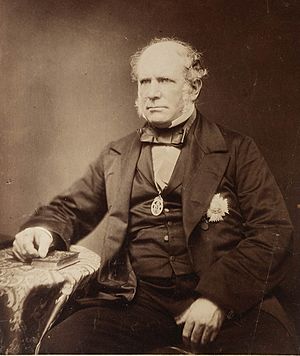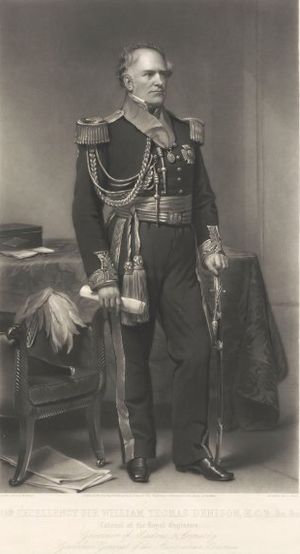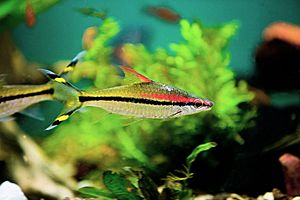William Denison facts for kids
Quick facts for kids
Sir William Denison
|
|
|---|---|

Sir William Denison, Sydney, 1859
|
|
| 7th Lieutenant-Governor of Van Diemen's Land | |
| In office 25 January 1847 – 8 January 1855 |
|
| Preceded by | Sir John Eardley-Wilmot |
| Succeeded by | Sir Henry Young |
| 11th Governor of New South Wales | |
| In office 13 January 1855 – 21 January 1861 |
|
| Monarch | Victoria |
| Premier | Stuart Donaldson |
| Preceded by | Sir Charles FitzRoy |
| Succeeded by | Sir John Young |
| 27th Governor of Madras | |
| In office 1861–1866 |
|
| Preceded by | William Ambrose Morehead |
| Succeeded by | The Lord Napier |
| Personal details | |
| Born | 3 May 1804 London, England |
| Died | 19 January 1871 (aged 66) East Sheen, Surrey, England |
| Spouse | Caroline Hornby |
| Education | Eton College |
| Alma mater | Royal Military Academy Sandhurst |
Sir William Thomas Denison (born May 3, 1804 – died January 19, 1871) was an important British leader. He served as a governor in several parts of the British Empire. He was the Lieutenant-Governor of Van Diemen's Land (now Tasmania) from 1847 to 1855. Later, he became the Governor of New South Wales from 1855 to 1861. His last major role was as Governor of Madras (in India) from 1861 to 1866.
People thought Denison was a good leader and very organized. When he was in Tasmania, he sometimes spoke too openly about the colonists. This caused some issues, especially during times when people wanted to stop convicts being sent there. But he cared a lot about the colony. He helped improve education, science, and trade. This helped Tasmania become a successful place. In New South Wales, his job was a bit easier. He managed the new self-governing system well.
Contents
Early Life and Education
William Denison was born in London, England. He was the third son of John Denison, a Member of Parliament. William went to a private school before attending Eton College. He also studied at the Royal Military College, Sandhurst. In 1826, he joined the Royal Engineers. This was a special part of the army focused on engineering. In November 1838, he married Caroline Hornby.
Engineering Work in Canada
As a young engineer, Lieutenant Denison worked on the Rideau Canal in Upper Canada (now part of Ontario). This was between 1826 and 1832. He helped build this important waterway. Denison even did tests to see how strong Canadian timber was for building. His findings were so good that he won the famous Telford Medal in silver. This award came from the Institution of Civil Engineers in England.
He returned to England in 1831. He worked at Woolwich and taught at Chatham. In 1837, he became the engineer in charge of Woolwich Dockyard. He was promoted to captain in 1841. In 1844, he worked on a special group looking at public health in towns. Denison was knighted in 1846 for his work with the Admiralty.
Governor of Van Diemen's Land
In 1846, Denison was asked to be the Lieutenant-Governor of Van Diemen's Land. He arrived in Hobart on January 25, 1847. At this time, there were problems with the local government. Some members of the Legislative Council had resigned. They were protesting the high costs of the prison system. These costs were partly paid by the people of Tasmania.
Denison was told that no more convicts would be sent to the colony. This was meant to help solve the problem. However, the Legislative Council did not have enough members to make decisions. Denison decided to rule without a fully working Council. This meant he could not pass new laws easily. He had disagreements with the judges about local tax laws.
Denison also wrote a report about the colonists. In this report, he said some things that made him unpopular. His views on stopping convicts from being sent to the colony also caused issues. However, he did try to make things better. He gave land in Hobart for a school that would be open to everyone.
The British government had promised to stop sending male convicts to Tasmania. But then, they started sending large numbers again. This made many colonists angry. The Australasian Anti-Transportation League was formed to fight against this. They had strong support from people across Australia. The discovery of gold in Australia also helped. It meant fewer crimes in England and more prisons there. So, in 1852, the transport of prisoners to Van Diemen's Land finally stopped. Denison then closed the penal settlement on Norfolk Island.
During this time, people also wanted more self-government. In 1850, a new law was passed for the Australian colonies. This law allowed for new elected councils. In Tasmania, a council of 16 members was elected. All of them supported stopping convict transportation. This meant the governor's power was much less.
Denison became more popular towards the end of his time in Tasmania. In September 1854, he learned he would become Governor of New South Wales. When he left Hobart on January 13, 1855, the colonists gave him money to buy a special gift. This was a way to thank him for his time there. One of his last official actions was to support changing the colony's name to Tasmania.
Governor of New South Wales
Denison became Governor of New South Wales on January 20, 1855. In 1856, he also became "Governor-General" for all the Australian colonies. This role was meant to help the colonies work together. During the Crimean War, he made Sydney's defenses stronger. He improved forts like Fort Denison.
He helped set up the new two-house system of government in New South Wales. He was wise in handling the new challenges. This included giving power to the new Parliament of New South Wales. He also successfully argued against putting New England and the Clarence Valley into the new colony of Queensland. In 1859, he appointed Queensland's first Legislative Council. He also started the process for electing its Legislative Assembly.
Denison opened the colony's first railway in 1855. He also worked on improving postal services with the United Kingdom. He helped with agreements about taxes between colonies. He also worked on setting up lighthouses.
Denison was in charge of closing the convict colony on Norfolk Island. He also helped move the descendants of the Bounty mutineers from Pitcairn Island to Norfolk Island. He gave good advice to the governor of New Zealand. This advice might have helped avoid the New Zealand Wars. In November 1860, he learned he was appointed governor of Madras. He left Sydney on January 22, 1861.
Governor of Madras
In India, Denison's first job was to reorganize the Sepoy army. This was after the Indian Rebellion of 1857. He believed in strong public works and irrigation projects. His engineering background was very helpful here. In 1865, he passed a law to improve towns. He also updated how land taxes were collected. In November 1863, he became the temporary Governor-General of India for two months.
In March 1866, he retired and went back to England. He wrote a book about his life as a governor. He also led a group studying river pollution in Britain until he died. He passed away in East Sheen, Surrey. He was survived by his wife, Caroline Lucy, and many children.
Denison was interested in science. He supported studies on the natural history of India. He was also a strong Christian.
Honours and Legacy
The Institution of Civil Engineers gave him the important Telford Medal in 1837. This was for his work testing the strength of Canadian timber. He was one of the first people to receive this award.
Denison was knighted before he went to Tasmania. He was made a Knight Commander of the Order of the Bath (K.C.B.) in 1856.
Several places in Tasmania were named after Denison. These include a federal and a state electoral division. Port Denison in Queensland was also named after him.
Animals and Plants Named After Denison
Two species from India are named after William Denison:
- A fish called the Denison barb (Sahyadria denisonii). This fish is found in the Western Ghats.
- A plant called Impatiens denisonii. This plant grows in the Nilgiri hills.
A group of Australian venomous snakes, called Denisonia, is also named in his honour.



